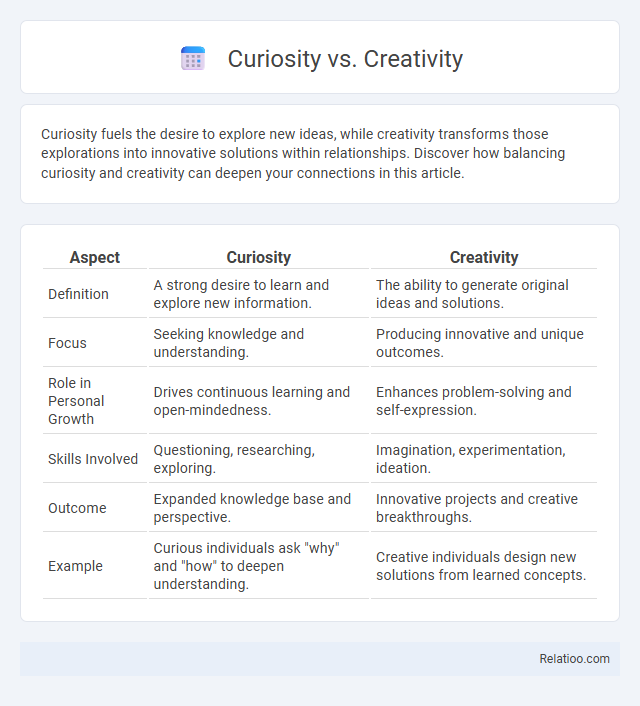Curiosity fuels the desire to explore new ideas, while creativity transforms those explorations into innovative solutions within relationships. Discover how balancing curiosity and creativity can deepen your connections in this article.
Table of Comparison
| Aspect | Curiosity | Creativity |
|---|---|---|
| Definition | A strong desire to learn and explore new information. | The ability to generate original ideas and solutions. |
| Focus | Seeking knowledge and understanding. | Producing innovative and unique outcomes. |
| Role in Personal Growth | Drives continuous learning and open-mindedness. | Enhances problem-solving and self-expression. |
| Skills Involved | Questioning, researching, exploring. | Imagination, experimentation, ideation. |
| Outcome | Expanded knowledge base and perspective. | Innovative projects and creative breakthroughs. |
| Example | Curious individuals ask "why" and "how" to deepen understanding. | Creative individuals design new solutions from learned concepts. |
Defining Curiosity and Creativity
Curiosity is the innate desire to explore and acquire new knowledge, driving your quest for understanding the unknown. Creativity involves the ability to generate original ideas and solutions by connecting diverse concepts in innovative ways. Both curiosity and creativity fuel intellectual growth, but curiosity initiates the pursuit of information, while creativity transforms it into novel expressions or inventions.
The Science Behind Curiosity
Curiosity drives the brain to seek new information, activating the reward system through dopamine release, which enhances learning and memory retention. Neuroscientific studies reveal that curiosity stimulates the hippocampus, a key region for encoding and retrieving information, differentiating it from creativity, which primarily involves the prefrontal cortex. This neurological foundation explains why curiosity is a potent catalyst for knowledge acquisition and cognitive growth.
Understanding the Nature of Creativity
Curiosity drives the desire to explore and ask questions, fueling the initial spark of creativity by gathering diverse information. Creativity synthesizes this knowledge into novel ideas and solutions, reflecting an active cognitive process of making connections beyond existing paradigms. Understanding the nature of creativity involves recognizing how curiosity acts as a catalyst that stimulates associative thinking, leading to original and valuable outcomes.
How Curiosity Fuels Creativity
Curiosity drives the desire to explore new ideas and discover unknown concepts, serving as the catalyst for creative thinking and innovation. By constantly questioning and seeking out novel information, curiosity expands the mind's horizon, providing the raw material for creative problem-solving and original expression. This unending quest for knowledge ignites the imagination, bridging the gap between curiosity and creativity.
Key Differences Between Curiosity and Creativity
Curiosity drives your desire to explore and acquire new information, while creativity transforms that knowledge into original ideas and solutions. Key differences lie in curiosity's focus on asking questions and seeking understanding, whereas creativity emphasizes inventiveness and applying insights in novel ways. Understanding these distinctions helps enhance both your learning process and innovative potential.
The Interplay of Curiosity and Creativity in Problem-Solving
Curiosity drives the exploration of unknown areas, prompting individuals to ask questions and seek new information, while creativity transforms these insights into innovative solutions. The interplay of curiosity and creativity enhances problem-solving by enabling a continuous cycle of discovery and imaginative application, leading to more effective and original outcomes. This dynamic relationship supports adaptive thinking and fosters the development of novel strategies in complex challenges.
Real-Life Examples: Curiosity vs Creativity
Curiosity drives exploration and the desire to acquire new knowledge, as seen in scientists investigating unknown phenomena, while creativity applies that knowledge to generate innovative solutions, like engineers designing advanced technology. Your curiosity sparks questions that challenge the status quo, paving the way for creative problem-solving in fields such as art, business, and education. Real-life examples include Leonardo da Vinci's inquisitive studies leading to groundbreaking inventions and Steve Jobs' creative use of curiosity-driven insights to revolutionize personal computing.
Enhancing Curiosity for Greater Creativity
Enhancing curiosity fuels your creative potential by driving exploration and the desire to learn, which sparks innovative ideas and solutions. Curiosity encourages open-mindedness and the continuous pursuit of knowledge, expanding the cognitive pathways necessary for creativity to thrive. Fostering a curious mindset empowers you to ask deeper questions and connect disparate concepts, significantly boosting creative output and problem-solving skills.
Overcoming Barriers to Curiosity and Creativity
Overcoming barriers to curiosity and creativity involves addressing psychological blocks such as fear of failure, fixed mindset, and lack of motivation. Encouraging a growth mindset, fostering a safe environment for experimentation, and providing diverse stimuli are essential strategies to enhance inquisitiveness and innovative thinking. Integrating reflective practices and collaborative brainstorming can further dismantle cognitive obstacles, promoting sustained curiosity and creative output.
Cultivating a Balance Between Curiosity and Creativity
Cultivating a balance between curiosity and creativity enhances your ability to generate innovative solutions while exploring new ideas deeply. Curiosity drives the desire to learn and question, providing the raw material for creative thinking, which transforms these insights into original concepts. By nurturing both traits, you improve problem-solving skills and foster continuous personal and professional growth.

Infographic: Curiosity vs Creativity
 relatioo.com
relatioo.com